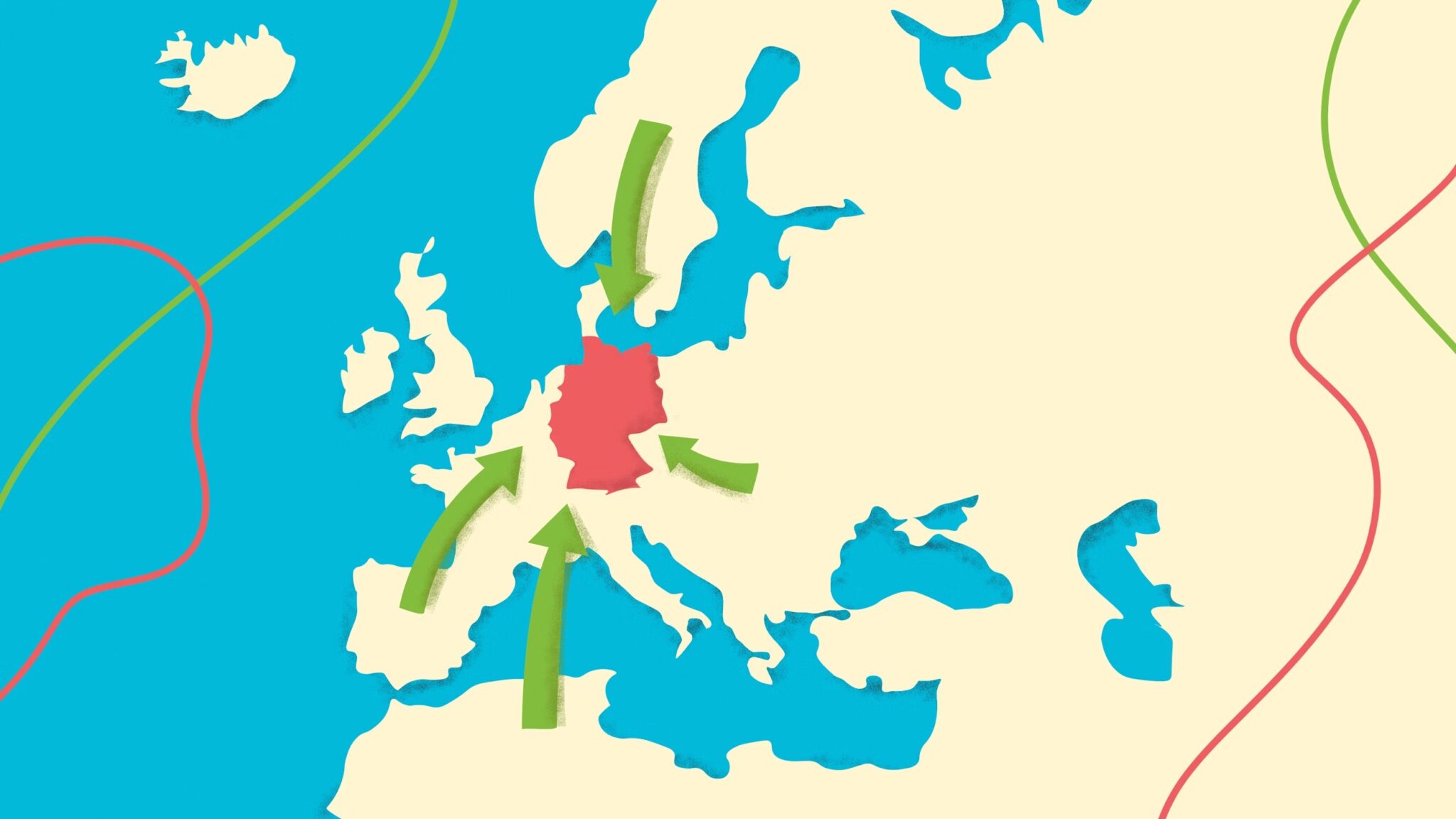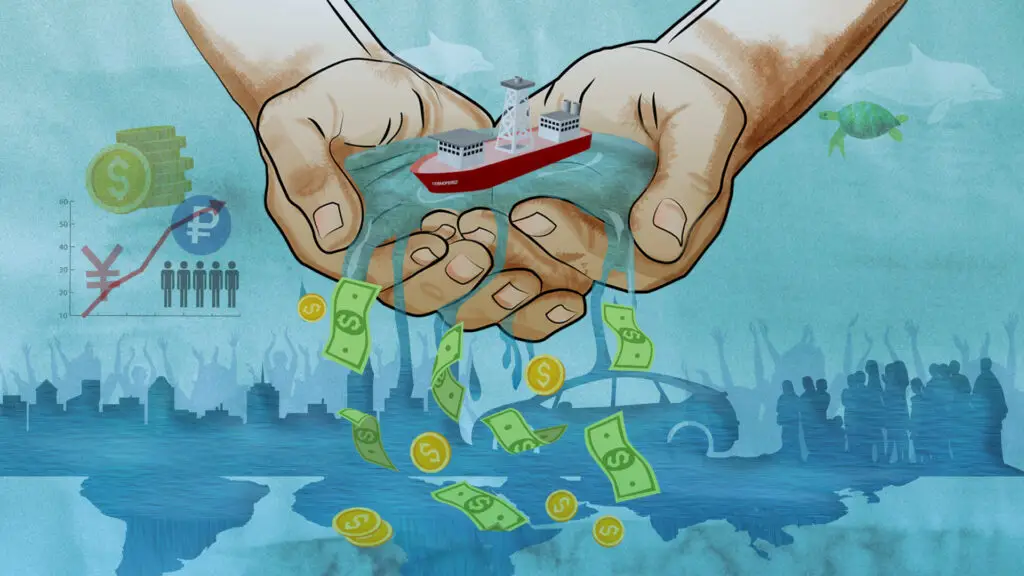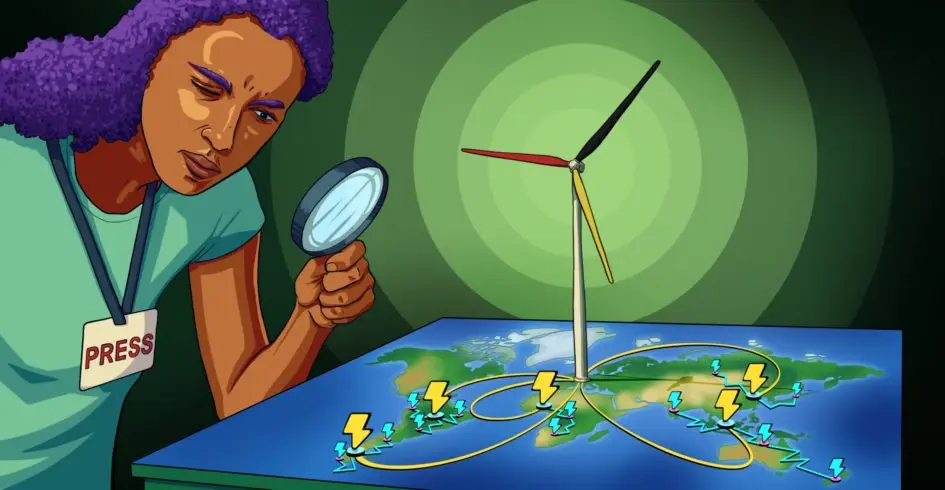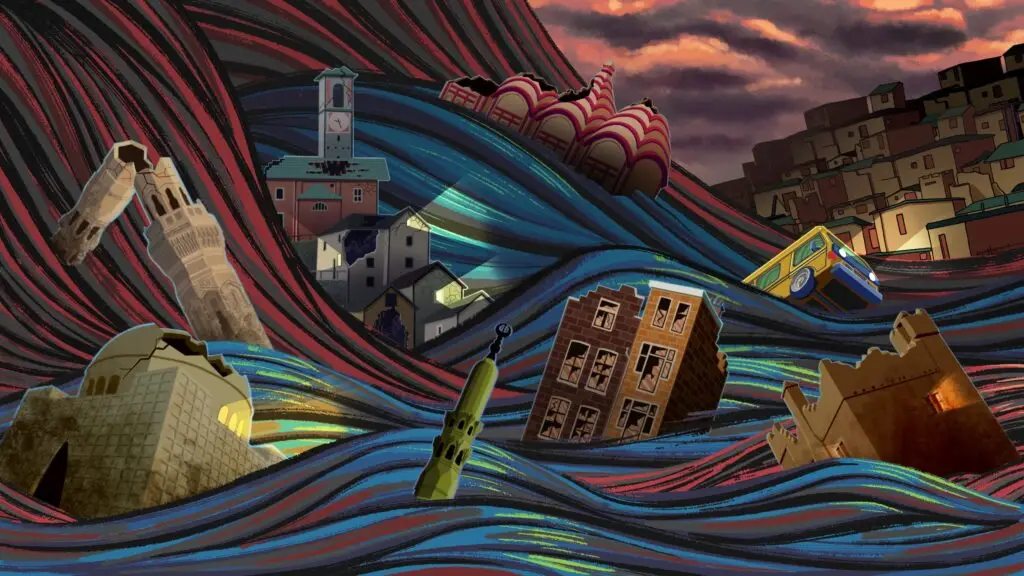The destination of my journey is somewhat hidden at the end of a small country road. Like a closely guarded military base, it is located far from settlements in the hinterland, among scraps of coniferous forest, behind meadows and fields. A large gate interrupts the fence that circles the expansive railing, signaling: I’m here, at the Saerbeck Bioenergy Park. Wind turbines, biogas plants and solar parks generate not only energy here, but also good returns for the residents of the small Westphalian community.
Right here, in this inconspicuous place, a genuine world first is being celebrated. A world first that may only seem particularly spectacular to those people who are deeply involved in the matter – but which is nevertheless a small but important part of a much larger turning point in time.
On this day, the still young company Enapter will present the world’s first megawatt AEM electrolyzer. A device that can produce hydrogen from electricity in larger quantities for the first time using a technology that is still quite new. For this special occasion, Mona Neubaur, Green Minister of Economics of North Rhine-Westphalia, has also come to Saerbeck from Düsseldorf. She stands on stage in a white marquee in front of a few dozen suit-wearing gentlemen and says: “You show that it is possible to generate sufficient hydrogen from renewable energies in North Rhine-Westphalia, too, and to supply the share we can deliver.”
Green hydrogen: the "new oil", made in Germany.
This is becoming more of a reality day by day with companies like Enapter. But the reality is also: German industry has long consumed significantly more hydrogen than Enapter or any other company will be able to produce in a climate-neutral way in this country in the foreseeable future. Instead, most of the hydrogen consumed today is still produced from fossil raw materials – and has a miserable climate footprint.
It is therefore clear that if green hydrogen is to be an important piece of the puzzle for clean energy supply in the future, a large part of it will have to come from abroad. Where exactly – that’s the subject of this and the next part of the series.
First, we will focus on Germany and Europe. The third and last part will then deal with the vision of a global hydrogen economy, as we have today with oil and fossil fuels.
Green hydrogen: Made in Germany?
The most obvious place to produce hydrogen for Germany is … Germany. We just need to build enough wind turbines and photovoltaic plants, connect them to appropriate electrolysers – and the hydrogen will flow. Or will it?
As we know, it is already challenging enough for Germany to produce enough renewable power sources to replace coal, gas and uranium. Because some energy is always lost when electricity is converted to hydrogen or hydrogen is converted back to electricity, even more wind power and photovoltaic plants would have to be built if we wanted to package and distribute all our domestically generated green electricity in hydrogen. And that would accordingly raise energy costs. For short distances inland, it will therefore always be advantageous to use the electricity directly, if possible. Experts are largely in agreement on this point.
But that’s not always possible. Even today, wind farms in northern Germany are partially shut down on windy days because the power lines can’t transport the amount of energy. Wouldn’t it make sense to convert this surplus electricity into hydrogen on site?
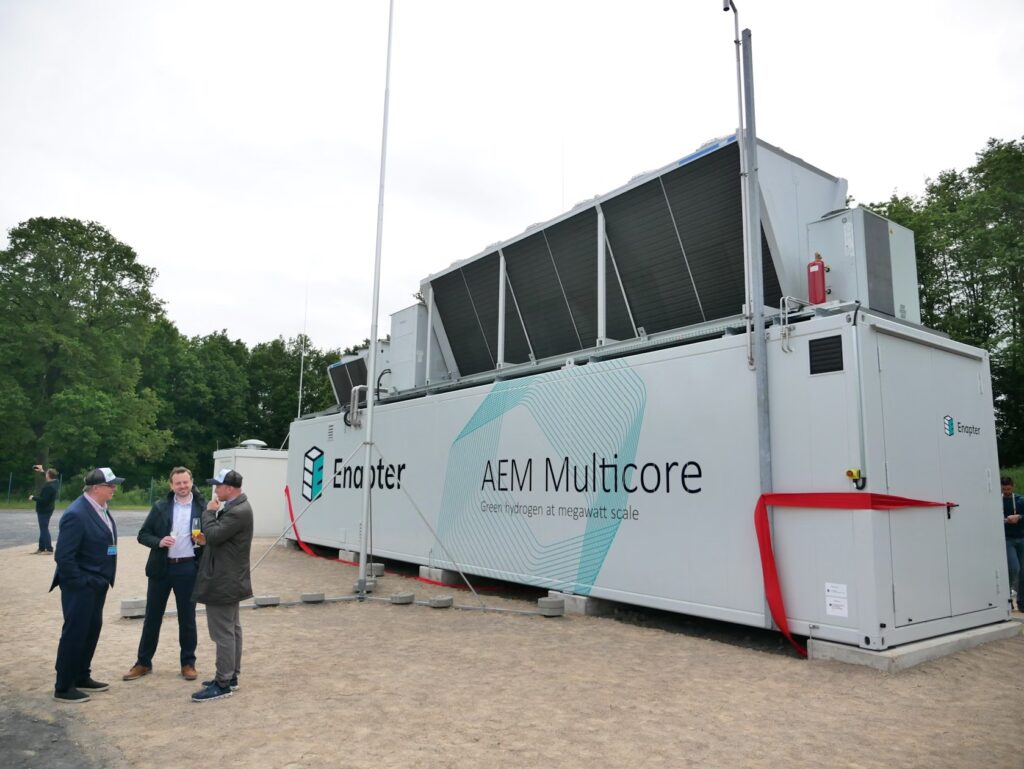
What sounds good, however, does not lead very far in practice, argues Volker Quaschning, Professor of Renewable Energy Systems at the University of Applied Sciences in Berlin, in his book “Energierevolution Jetzt!” In 2019, for example, just 3% of wind power was curtailed. If expensive electrolysers were now built in these wind farms, which produced hydrogen only a few days a year, this hydrogen would be scarce and expensive. New power lines connecting the north with the south must be built in any case, also to transport the electricity from future offshore wind farms to the south.
However, the further the expansion of renewables progresses, the greater the overcapacities on sunny and windy days will become. At the same time, the price of hydrogen technology is likely to fall rapidly in the next few years, which could make it increasingly worthwhile to set up electrolysers to temporarily store surplus electricity in hydrogen. In the long term, this could also be used to build up energy reserves for the winter. However, it will probably be many years before this pays off on a large scale.
All this applies to scenarios with large volumes and favorable prices. Beyond that, however, there are many situations in which the production of hydrogen can be worthwhile even earlier. For industrial companies or residential associations, for example, who are aiming to be as energy self-sufficient as possible and who want to store even large quantities of energy quickly. Solutions that, by the way, Enapter also specializes in.
The world’s first megawatt AEM electrolyzer, which the company celebrated in May, is actually a large container in which the company has stacked 420 of its small modular electrolyzers. In keeping with the Lego building-block principle, any number of these can in principle be connected together to create an electrolyzer of any size. At the same time, the company supplies its electrolyzers together with a suitable app that can be used to control and monitor the device.
This is a solution that can also be used by private tinkerers who want to experiment with hydrogen in their own homes. Some in the industry therefore compare Enapter’s business approach with Apple, which did not invent the home computer, but simplified it so much that anyone could do something with it. And in doing so, they ultimately brought it to the mass market.
Use without regret: Where green hydrogen gets the green light sooner
Once again, different rules apply to German industry, where hydrogen is already consumed in large quantities as a basic material. However, this is mainly so-called grey or blue hydrogen with a poor climate balance, as green hydrogen is not yet available in sufficient quantities at affordable prices. Of course, these industries must also be decarbonized; this is to be achieved with the help of green hydrogen.
For the climate-neutral production of steel, for example, hydrogen is largely without alternative for chemical reasons – hence the term “no-regret” applications. (More on this in Part 1 of the Hydrogen Series.) In the future, there will probably be high levels of government subsidies for these applications, so that climate-neutral and thus more expensive steel or other industrial products from Germany remain internationally competitive.
The Carbon Contracts for Difference (CCfD) program is the first such major program to be launched this June. It is intended to use an auction process to bridge the price gap that arises for companies that focus on climate-friendly production with the help of green hydrogen. The initial focus is on the steel and chemical industries, where large amounts of CO2 can be saved particularly quickly. A new analysis shows just how much can be saved there: According to the study, Thyssen-Krupp’s Duisburg plants alone emit 16 megatons of CO2 a year, more than the country of Lithuania.
In the next step, sectors such as the paper, glass and cement industries are also to be included. In addition to directly saving emissions, this instrument is intended to help spread climate-friendly production technologies more widely so that they can also become competitive in the medium term.
So far, green hydrogen has only been used in individual pilot projects in industry. It is often transported by tanker truck from small plants or neighboring countries to where it is needed. The GetH2-Nucleus project, run by a consortium of major energy companies, now aims to take hydrogen to the next level.
By 2030, more than 500 kilometers of hydrogen pipelines in Germany - mainly in industrial conurbations in North Rhine-Westphalia - will connect large electrolysers with chemical parks, refineries and factories.
But things will start on a somewhat smaller scale as early as 2024: In Lingen, where the fuel rods of one of Germany’s last nuclear power plants are currently decaying, RWE will use wind and solar power to produce large quantities of hydrogen in the future. With an output of 100 megawatts, this electrolyzer will absorb as much power as around 30 large wind turbines. This green hydrogen will then flow through former natural gas pipelines to the Marl Chemical Park of the chemical company Evonik and to the Ruhr Oel refinery in Gelsenkirchen of the oil giant BP.
In a nutshell: The first priority for green hydrogen in Germany is heavy industry – because here there is no alternative to hydrogen for decarbonization. However, it will be years before sufficient green hydrogen is available for this sector alone. This is also because every kilogram of green hydrogen produced in Germany ensures that green electricity is lacking elsewhere in the energy transition. That’s why it won’t work without imports.
Green hydrogen from the European neighborhood
Around Germany, there are countries and regions that have significantly better geographic conditions for producing large amounts of renewable energy and also green hydrogen. Before we go through them one by one, there is one important point that unites them all: They are located in relative proximity to Germany and the major industrial sites in central Europe – and are thus within reach of pipelines.
As a gas, hydrogen is ideally suited to being transported through pipelines. Many existing pipelines from abroad, through which natural gas has flowed up to now, can be easily converted for green hydrogen in the future.
To transport as much energy as possible over long distances as quickly as possible, pipelines are unrivaled – and unrivaled in price.
By 2040, a network of hydrogen pipelines could stretch across Europe from the far north of Norway to the northern coast of Africa and from Ireland to Turkey. It would connect major hydrogen production sites, cavern storage facilities, ports for landing liquefied hydrogen, and central industrial areas. The European Hydrogen Backbone project has created an interactive map showing the possible future hydrogen network.
Like CO2 or methane, hydrogen acts as a greenhouse gas in the atmosphere. Its global warming potential is about 3 to 5 times higher than that of CO2. Unlike CO2, however, it is not a waste product and escapes into the atmosphere in much smaller quantities. Since there are always leaks during transport in pipelines, the climate balance of green hydrogen is somewhat clouded when it is imported by pipeline.
So where could Germany obtain hydrogen by pipeline in the future?
From the North: Earlier this year, Germany and Norway announced plans to build a hydrogen pipeline between the two countries by 2030. Initially, blue hydrogen is to flow through the pipe at the bottom of the North Sea, later green. In sparsely populated, hilly and coastal Norway, there is huge potential for wind and water power, which will be used to produce green hydrogen in the future. There are similar plans in Sweden and Finland. Gigantic wind farms will also be built off the coasts of tiny Denmark in the next few years, and their energy harvest is to be converted into hydrogen directly on site and pumped to Germany.
From the East: Even though the situation has changed in the meantime and is difficult to predict, Ukraine was also considered a possible supplier of green hydrogen until 2 years ago. The pipelines have been in place for a long time, and at the same time the country is about twice as big as Germany – with about half as many inhabitants. So there’s plenty of room for wind and photovoltaic farms.
Even Russia has recently positioned itself as a supplier of “climate-friendly” hydrogen. However, the country was more interested in producing blue or turquoise hydrogen from its gigantic natural gas reserves. For the time being, however, energy trade between Russia and Europe is likely to remain on hold.
From the South: Perhaps the greatest hopes for large hydrogen supplies lie in the south. Spain in particular has enormous potential for photovoltaic plants. Hydrogen produced there could reach Germany in the future, partly via existing pipelines and partly via new ones. But the main prize lies a little further south: in northern Africa. Almost no people live in the vast expanses of the Sahara, and the land and hours of sunshine here are almost limitless. Today, five pipelines already deliver natural gas from the Maghreb through the Mediterranean to Europe; they could contain hydrogen in the future.
But with the exception of Morocco, many of these countries are politically unstable. Large investments, reliable supplies, all this is currently uncertain. This is also the conclusion of the MENA study (MENA stands for Middle East and North Africa) published by the Wuppertal Institute in November 2022, in which the scientists state that these regions could produce many times more hydrogen and synthetic fuels than Germany needs. But the people in the local countries would have to benefit from the projects in order to create the necessary acceptance and stability. (More on this in the next part of the series.)
From the West: Most recently, Great Britain broke away from mainland Europe. In terms of energy, it could grow together again in the next few decades. The UK has strong, steady winds, especially off its coasts, which it would like to harvest in the future in offshore wind farms to produce green hydrogen, which in turn will flow to the European mainland.
Hydrogen will play a major role in the energy supply of Germany and Europe - and there is much to suggest that this will also be the case for the rest of the world.
Electricity has the advantage over hydrogen that there are fewer conversion losses. But in hydrogen, energy can be stored and transported like in no other way. That’s why there is much to suggest that there will be a global hydrogen economy in the future, comparable to today’s trade in oil.
What exactly this could look like, who the winners will be and what opportunities and risks this will entail – both for the climate and for many countries and people who still suffer from energy poverty today – is what the upcoming third part of the hydrogen series will be about.
Originally published in German by Perspective Daily. Translation by Tina Lee.
Read more in this series:

This project was funded by the European Journalism Centre, through the Solutions Journalism Accelerator. This fund is supported by the Bill & Melinda Gates Foundation.

